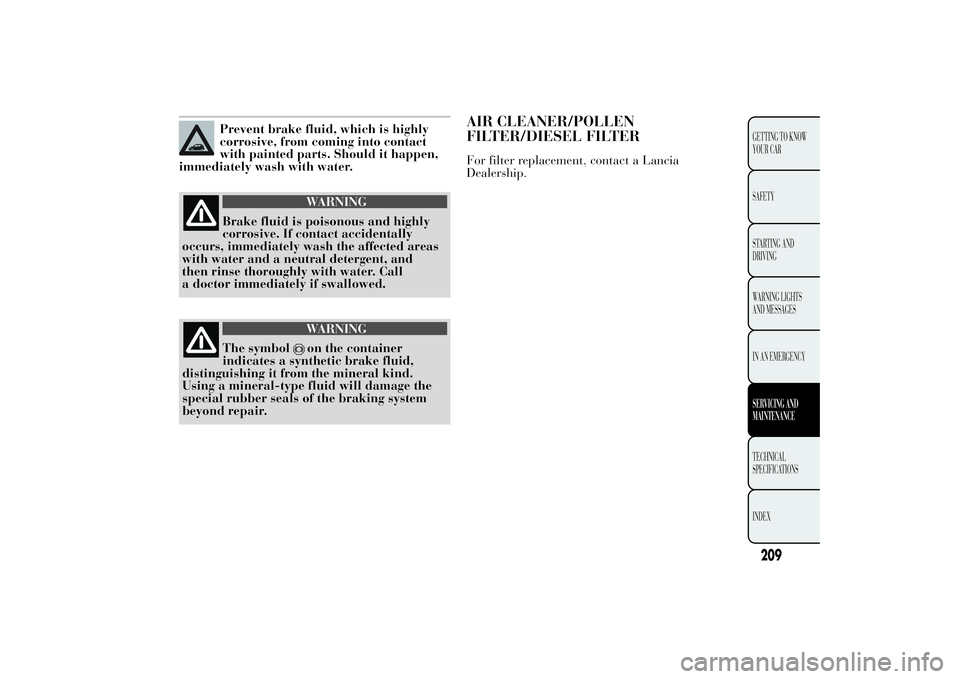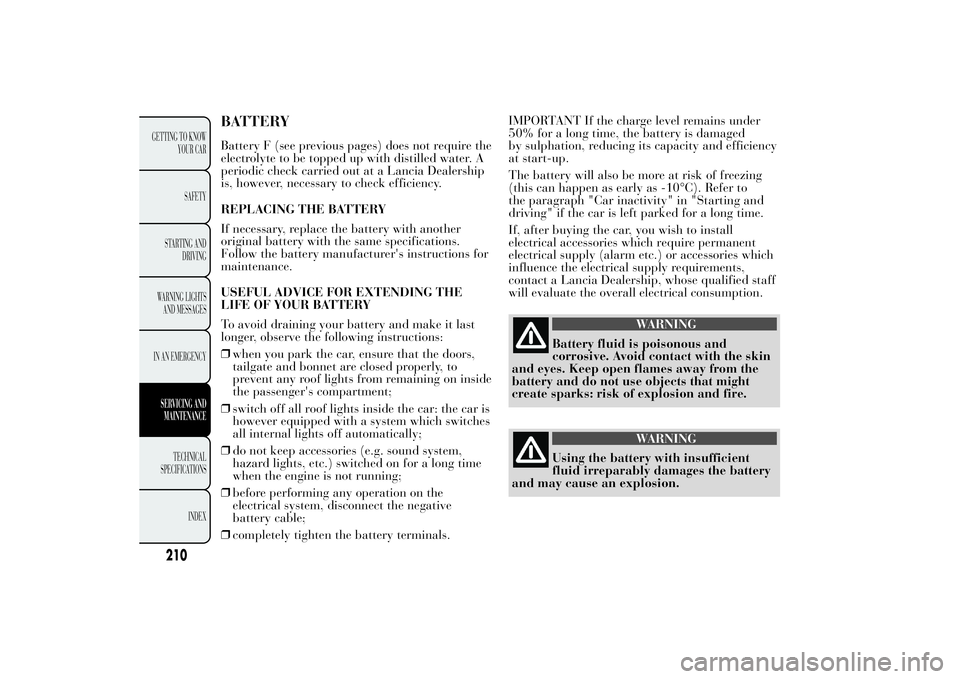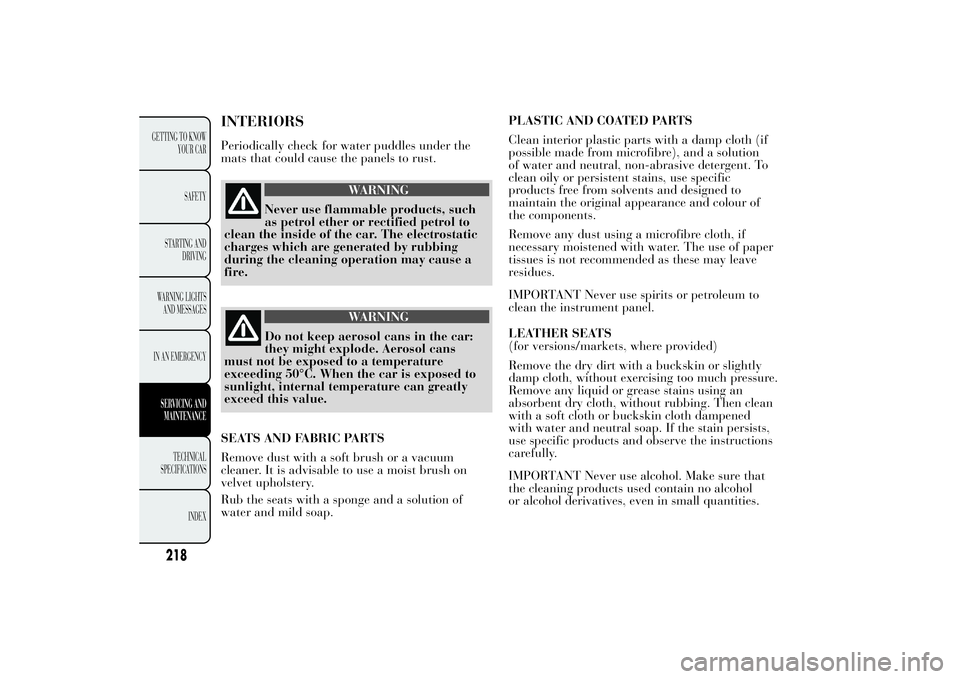Lancia Ypsilon 2011 Owner handbook (in English)
Manufacturer: LANCIA, Model Year: 2011, Model line: Ypsilon, Model: Lancia Ypsilon 2011Pages: 299, PDF Size: 13.35 MB
Page 211 of 299

Prevent brake fluid, which is highly
corrosive, from coming into contact
with painted parts. Should it happen,
immediately wash with water.
WARNING
Brake fluid is poisonous and highly
corrosive. If contact
accidentally
occurs, immediately wash the affected areas
with water and a neutral detergent, and
then rinse thoroughly with water. Call
a doctor immediately if swallowed.
WARNING
The symbol
on the container
indicates a synthetic brake fluid,
distinguishing it from the mineral kind.
Using a mineral-type fluid will damage the
special rubber seals of the braking system
beyond repair.
AIR CLEANER/POLLEN
FILTER/DIESEL FILTERFor filter replacement, contact a Lancia
Dealership.
209GETTING TO KNOW
YOUR CAR
SAFETY
STARTING AND
DRIVING
WARNING LIGHTS
AND MESSAGES
IN AN EMERGENCYSERVICING AND
MAINTENANCETECHNICAL
SPECIFICA
TIONS
INDEX
Page 212 of 299

BATTERYBattery F (see previous pages) does not require the
electrolyte to be topped up with distilled water. A
periodic check carried out at a Lancia Dealership
is, however, necessary to check efficiency.
REPLACING THE BATTERY
If necessary, replace the battery with another
original battery with the same specifications.
Follow the battery manufacturer's instructions for
maintenance.
USEFUL ADVICE FOR EXTENDING THE
LIFE OF YOUR BATTERY
To avoid draining your battery and make it last
longer, observe the following instructions:
❒when you park the car, ensure that the doors,
tailgate and bonnet are closed properly, to
prevent any roof lights from remaining on inside
the passenger's compartment;
❒switch off all roof lights inside the car: the car is
however equipped with a system which switches
all internal lights off automatically;
❒do not keep accessories (e.g. sound system,
hazard lights, etc.) switched on for a long time
when the engine is not running;
❒before performing any operation on the
electrical system, disconnect the negative
battery cable;
❒completely tighten the battery terminals.IMPORTANT If the charge level remains under
50% for a long time, the battery is damaged
by sulphation, reducing its capacity and efficiency
at start-up.
The battery will also be more at risk of freezing
(this can happen as early as -10°C). Refer to
the paragraph "Car inactivity" in "Starting and
driving" if the car is left parked for a long time.
If, after buying the car, you wish to install
electrical accessories which require permanent
electrical supply (alarm etc.) or accessories which
influence the electrical supply requirements,
contact a Lancia Dealership, whose qualified staff
will evaluate the overall electrical consumption.
WARNING
Battery fluid is poisonous and
corrosive. Avoid
contact with the skin
and eyes. Keep open flames away from the
battery and do not use objects that might
create sparks: risk of explosion and fire.
WARNING
Using the battery with insufficient
fluid irreparably damages
the battery
and may cause an explosion.
210
GETTING TO KNOW
YOUR CAR
SAFETY
STARTING AND
DRIVING
WARNING LIGHTS
AND MESSAGES
IN AN EMERGENCYSERVICING AND
MAINTENANCE
TECHNICAL
SPECIFICA
TIONS
INDEX
Page 213 of 299

Incorrect installation of electrical and
electronic devices may cause severe
damage to your car. After purchasing
your car, if you wish to install any accessories
(car alarm, car phone etc.), contact a Lancia
Dealership, which will suggest the most
appropriate devices for your vehicle and will,
most importantly, advise you if a
higher-capacity battery needs to be installed.Batteries contain substances which are
very dangerous for the environment.
For battery replacement, contact a
Lancia Dealership.
WARNING
If the car will be unused for an
extended period of
time in extremely
cold weather conditions, remove the battery
and store it in a heated area to avoid it
freezing.
WARNING
Always wear appropriate goggles
when working on
or near the battery.
WHEELS AND TYRESBefore long trips, and every two weeks, check the
tyre and space-saver wheel inflation pressure
(for versions/markets, where provided). Check the
tyres when cold.
While driving the car, the pressure increases under
standard conditions: for the correct tyre inflation
pressure, see "Wheels" paragraph in the
"Technical specifications" chapter.
Incorrect pressure causes abnormal tyre wear fig.
161:
A normal pressure: tread evenly worn;
B low pressure: tread particularly worn at the
edges;
C high pressure: tread particularly worn in the
centre.
fig. 161
L0F0018
211GETTING TO KNOW
YOUR CAR
SAFETY
STARTING AND
DRIVING
WARNING LIGHTS
AND MESSAGES
IN AN EMERGENCYSERVICING AND
MAINTENANCETECHNICAL
SPECIFICA
TIONS
INDEX
Page 214 of 299

The tyres must be replaced when the tread is less
than 1.6 mm thick. In any case, follow the laws
in force in the country where you are driving.
IMPORTANT
Take the following precautions to prevent damage
to the tyres:
❒avoid braking suddenly, racing starts and
violent impact against the curb, potholes or
other obstacles and driving for extended periods
on uneven road surfaces;
❒periodically check that the tyres have no cuts in
the side wall, abnormal swelling or irregular
tyre wear;
❒avoid travelling with the car overloaded. If you
have a puncture, stop immediately and change
the tyre;
❒tyres age even if they are not used much. Cracks
in the tread rubber and at the sides are a sign of
ageing. In any case, if the tyres have been on
the car for over 6 years, they should be checked
by specialised personnel. Also remember to
check the space-saver wheel very carefully (for
versions/markets, where provided);
❒change the position of the tyres every 10-15
thousand kilometres, keeping them on the same
side of the car to avoid inverting the direction
of rotation;❒In the case of replacement, always fit new tyres,
avoiding those of dubious origin;
❒if a tyre is changed, also change the inflation
valve.
WARNING
The road holding qualities of the car
also depend on
the correct inflation
pressure of the tyres.
WARNING
If the pressure is too low the tyre
overheats and this
can cause it
serious damage.
WARNING
Do not cross switch the tyres, moving
them from the
right of the car to the
left and vice versa.
WARNING
Never submit alloy rims to repainting
treatments requiring the
use of
temperatures exceeding 150°C. The
mechanical properties of the wheels could
be impaired.
212
GETTING TO KNOW
YOUR CAR
SAFETY
STARTING AND
DRIVING
WARNING LIGHTS
AND MESSAGES
IN AN EMERGENCYSERVICING AND
MAINTENANCE
TECHNICAL
SPECIFICA
TIONS
INDEX
Page 215 of 299

WINDSCREEN/REAR WINDOW
WIPERBLADES
Replace the blades if the rubber edge is deformed
or worn. In any event, it is advisable to replace
them approximately once a year.
A few simple precautions can reduce the
possibility of damage to the blades:
❒if the temperature falls below zero, make sure
that ice has not frozen the rubber against the
glass. Use an antifreeze product to release it
if required;
❒remove any snow from the glass: in addition to
protecting the blades, this prevents effort on
the motor and over-heating;
❒do not operate the windscreen/rear window
wipers on dry glass.
WARNING
Driving with worn windscreen/rear
window wiper blades
is a serious
hazard, because visibility is reduced in bad
weather.Replacing the windscreen wiper blades
Proceed as follows:
❒raise the wiper arm, press tab A fig. 162 of the
attachment spring and remove the blade from
the arm;
❒fit the new blade, inserting the tab into the
special slot in the arm, making sure that it
is locked.
❒lower the windscreen wiper arm on the
windscreen.
Do not operate the windscreen wiper
with the blades lifted from the
windscreen.
fig. 162
L0F0186
213GETTING TO KNOW
YOUR CAR
SAFETY
STARTING AND
DRIVING
WARNING LIGHTS
AND MESSAGES
IN AN EMERGENCYSERVICING AND
MAINTENANCETECHNICAL
SPECIFICA
TIONS
INDEX
Page 216 of 299

Replacing the rear window wiper blade
Proceed as follows:
❒raise cover A fig. 163, undo nut B and remove
arm C;
❒correctly position the new arm, fully tighten nut
B then lower cover A.SPRAY NOZZLES
Windscreen washer
The window washer jets A fig. 164 are fixed. If
there is no jet of fluid, firstly check that there
is fluid in the reservoir (see "Checking fluid
levels" in this chapter).
Then check that the nozzle holes are not clogged;
use a needle to unblock them if necessary.
IMPORTANT In versions with a sun roof, make
sure that the sun roof is closed before operating
the window washer jets.
fig. 163
L0F0222
fig. 164
L0F0221
214
GETTING TO KNOW
YOUR CAR
SAFETY
STARTING AND
DRIVING
WARNING LIGHTS
AND MESSAGES
IN AN EMERGENCYSERVICING AND
MAINTENANCE
TECHNICAL
SPECIFICA
TIONS
INDEX
Page 217 of 299

Rear window washer
The rear window washer jets are fixed. The nozzle
holder is on the rear window fig. 165.HEADLIGHT WASHERS
(for versions/markets, where provided)
They are located inside the front bumper fig. 166.
They are activated when the dipped beam and/or
main beam headlights are on and the windscreen
washer is activated.
Check the correct condition and cleanliness of
nozzles at regular intervals.
fig. 165
L0F0223
fig. 166
L0F0023
215GETTING TO KNOW
YOUR CAR
SAFETY
STARTING AND
DRIVING
WARNING LIGHTS
AND MESSAGES
IN AN EMERGENCYSERVICING AND
MAINTENANCETECHNICAL
SPECIFICA
TIONS
INDEX
Page 218 of 299

BODYWORKPROTECTION FROM ATMOSPHERIC
AGENTS
The car is equipped with the best available
technological solutions to protect the bodywork
against corrosion.
These are the most important:
❒painting products and systems which give the
car particular resistance to corrosion and
abrasion
❒use of galvanised (or pretreated) steel sheets,
with high resistance to corrosion
❒spraying the underbody, engine compartment,
wheel arch interiors and other parts with highly
protective wax products
❒spraying of plastic parts, with a protective
function in the more exposed points: underdoor,
inner wing, edges, etc.
❒use of “open” boxed sections to prevent
condensation and pockets of moisture from
triggering rust inside.
BODY AND UNDERBODY WARRANTY
Your car is covered by warranty against
perforation due to corrosion of any original
element of the structure or body.
For the general terms of this warranty, refer to
your Warranty Booklet.PRESERVING THE BODYWORK
Paint
Touch up abrasions and scratches immediately to
prevent the formation of rust.
Maintenance of paintwork consists of washing the
car: the frequency depends on the conditions
and environment where the car is used. For
example, in highly polluted areas, or if the roads
are spread with salt, it is advisable to wash the car
more frequently.
To correctly wash the car, proceed as follows:
❒remove the aerial from the roof to prevent
damage to it if the car is washed in an
automatic system;
❒if high pressure jets or cleaners are used to wash
the car, keep a distance of at least 40 cm from
the bodywork to avoid damage or alteration.
It should be remembered that the build up
of water can damage the car over a period of
time;
❒wash the body using a low pressure jet of water;
❒wipe the bodywork using a sponge with a
slightly soapy solution, frequently rinsing the
sponge;
❒rinse well with water and dry with a jet of air or
a chamois leather.
216
GETTING TO KNOW
YOUR CAR
SAFETY
STARTING AND
DRIVING
WARNING LIGHTS
AND MESSAGES
IN AN EMERGENCYSERVICING AND
MAINTENANCE
TECHNICAL
SPECIFICA
TIONS
INDEX
Page 219 of 299

Dry the less visible parts (e.g. door frames,
bonnet, headlight frames etc.) with special care, as
water may stagnate more easily in these areas.
The car should not be taken to a closed area
immediately, but left outside so that residual water
can evaporate.
Do not wash the car after it has been left in the
sun or with the bonnet hot: this may alter the
shine of the paintwork.
Exterior plastic parts must be cleaned in the same
way as the rest of the car.
Avoid parking under trees as much as possible; the
resin from trees dulls the paintwork and increases
the possibility of corrosion.
IMPORTANT Bird droppings must be washed off
immediately and thoroughly as the acid they
contain is particularly aggressive.
Detergents pollute the environment.
Only wash your car in areas equipped
to collect and treat wastewater from
this type of activity.In order to preserve the aesthetic
properties of the paintwork, abrasive
products and/or polishes should not be
used to clean the car.Windows
Use specific detergents and clean cloths to prevent
scratching or altering the transparency.
IMPORTANT Wipe the inside surface of the rear
window gently with a cloth in the direction of
the filaments to avoid damaging the heating
device.
Front headlights
Use a soft, damp cloth soaked in water and
detergent for washing cars.
IMPORTANT Never use aromatic substances (e.g.
petrol) or ketenes (e.g. acetone) for cleaning the
plastic lenses of the front headlights.
IMPORTANT When cleaning the car with a
pressure washer, keep the water jet at least 2 cm
away from the headlights.
Engine compartment
At the end of every winter, wash the engine
compartment thoroughly, taking care not to aim
the jet of water directly at the electronic control
units or at the windscreen wiper motors. Have this
operation performed at a specialised workshop.
IMPORTANT The washing should take place with
the engine cold and the ignition key in the STOP
position. After washing, make sure that the
various protective devices (e.g. rubber caps and
guards) have not been removed or damaged.
217GETTING TO KNOW
YOUR CAR
SAFETY
STARTING AND
DRIVING
WARNING LIGHTS
AND MESSAGES
IN AN EMERGENCYSERVICING AND
MAINTENANCETECHNICAL
SPECIFICA
TIONS
INDEX
Page 220 of 299

INTERIORSPeriodically check for water puddles under the
mats that could cause the panels to rust.
WARNING
Never use flammable products, such
as petrol ether
or rectified petrol to
clean the inside of the car. The electrostatic
charges which are generated by rubbing
during the cleaning operation may cause a
fire.
WARNING
Do not keep aerosol cans in the car:
they might explode.
Aerosol cans
must not be exposed to a temperature
exceeding 50°C. When the car is exposed to
sunlight, internal temperature can greatly
exceed this value.
SEATS AND FABRIC PARTS
Remove dust with a soft brush or a vacuum
cleaner. It is advisable to use a moist brush on
velvet upholstery.
Rub the seats with a sponge and a solution of
water and mild soap.PLASTIC AND COATED PARTS
Clean interior plastic parts with a damp cloth (if
possible made from microfibre), and a solution
of water and neutral, non-abrasive detergent. To
clean oily or persistent stains, use specific
products free from solvents and designed to
maintain the original appearance and colour of
the components.
Remove any dust using a microfibre cloth, if
necessary moistened with water. The use of paper
tissues is not recommended as these may leave
residues.
IMPORTANT Never use spirits or petroleum to
clean the instrument panel.
LEATHER SEATS
(for versions/markets, where provided)
Remove the dry dirt with a buckskin or slightly
damp cloth, without exercising too much pressure.
Remove any liquid or grease stains using an
absorbent dry cloth, without rubbing. Then clean
with a soft cloth or buckskin cloth dampened
with water and neutral soap. If the stain persists,
use specific products and observe the instructions
carefully.
IMPORTANT Never use alcohol. Make sure that
the cleaning products used contain no alcohol
or alcohol derivatives, even in small quantities.
218
GETTING TO KNOW
YOUR CAR
SAFETY
STARTING AND
DRIVING
WARNING LIGHTS
AND MESSAGES
IN AN EMERGENCYSERVICING AND
MAINTENANCE
TECHNICAL
SPECIFICA
TIONS
INDEX